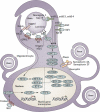Signals to promote myelin formation and repair
- PMID: 20404842
- PMCID: PMC3062363
- DOI: 10.1038/nrneurol.2010.37
Signals to promote myelin formation and repair
Abstract
The myelin sheath wraps large axons in both the CNS and the PNS, and is a key determinant of efficient axonal function and health. Myelin is targeted in a series of diseases, notably multiple sclerosis (MS). In MS, demyelination is associated with progressive axonal damage, which determines the level of patient disability. The few treatments that are available for combating myelin damage in MS and related disorders, which largely comprise anti-inflammatory drugs, only show limited efficacy in subsets of patients. More-effective treatment of myelin disorders will probably be accomplished by early intervention with combinatorial therapies that target inflammation and other processes-for example, signaling pathways that promote remyelination. Indeed, evidence suggests that such pathways might be impaired in pathology and, hence, contribute to the failure of remyelination in such diseases. In this article, we review the molecular basis of signaling pathways that regulate myelination in the CNS and PNS, with a focus on signals that affect differentiation of myelinating glia. We also discuss factors such as extracellular molecules that act as modulators of these pathways. Finally, we consider the few preclinical and clinical trials of agents that augment this signaling.
Figures



References
-
- Salzer JL, Brophy PJ, Peles E. Molecular domains of myelinated axons in the peripheral nervous system. Glia. 2008;56:1532–40. - PubMed
-
- Nave KA, Trapp BD. Axon-glial signaling and the glial support of axon function. Annu Rev Neurosci. 2008;31:535–61. - PubMed
-
- Bozzali M, Wrabetz L. Axonal signals and oligodendrocyte differentiation. Neurochem Res. 2004;29:979–88. - PubMed
-
- Simons M, Trajkovic K. Neuron-glia communication in the control of oligodendrocyte function and myelin biogenesis. J Cell Sci. 2006;119:4381–9. - PubMed
-
- Woodhoo A, Sommer L. Development of the Schwann cell lineage: from the neural crest to the myelinated nerve. Glia. 2008;56:1481–90. - PubMed
Publication types
MeSH terms
Substances
Grants and funding
LinkOut - more resources
Full Text Sources
Other Literature Sources
Medical

